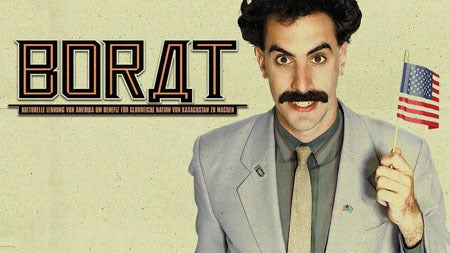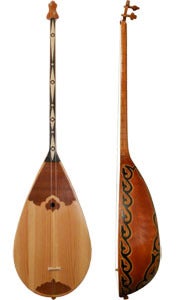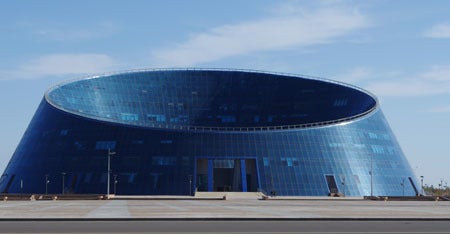
“Borat” trailer image
For most of us, Kazakhstan—indeed Eurasia generally—is terra incognita. Most of us couldn’t pinpoint it on a map. Most of us confuse it with the other “Stans.” If we do have any familiarity with it, it likely derives from Sacha Baron Cohen’s supremely silly film satire, Borat: Cultural Learnings of America for Make Benefit Glorious Nation of Kazakhstan.
Well, I, myself, was recently engaged in “cultural learnings” of Kazakhstan during a trip to Astana. I was part of an international review team assigned through the Association of European Conservatoires to look at the accreditation of the National University for the Arts. Astana is the country’s relatively new capital willed into existence by President Nursultan Nazarbayev in the early 1990s.
Before my trip, I did my background homework on the country (you can too by clicking here) and was, of course, particularly interested in the status of its musical culture. The Kazakhs’ musical tradition goes back nearly 2000 years and has always been the source of great pride and significance for the nation. Once on the ground, seeing and hearing their traditional instruments, instrumentalists and vocalists was like moving through a time warp, immensely enjoyable and full of discoveries and surprises. Since returning I have tried to do some research on the instruments and music I was introduced to but what I have found online is very different to what I experienced live and in the flesh. So I will use my direct experience, inaccurate or biased as it may be, to paint a picture of a truly astonishing living cultural legacy.

Dombra
The two major musical instruments are the Dombra and the Kobyz. The Dombra is a type of two-stringed, strummed mandolin but with a long neck, which is played either solo or in small ensembles. It is an instrument for virtuosi and that is what I kept hearing, beautiful folk melodies performed with movement, commitment and sheer joy by young male musicians clearly relishing the act of musical engagement. The Dombra is often made from complete blocks of wood, mulberry or apricot, and is fretless, the musicians running up and down the fingerboard with the ease of athletes in full flight. The Kobyz is completely different and is played mostly by women. It looks like a pear shaped violin and is a little bit larger, but is played on the lap like a cello. The bows I saw were basically violin bows and held in the same way. The Kobyz has four strings tuned like a violin but the strings are suspended without a fingerboard although they make a sound very similar to a violin. The first time I saw an ensemble of these being played I couldn’t work out how it was being done. The musicians’ fingers seemed to be suspended in mid air and yet they were able to run around with fast passages and scales as easily as a violinist and move up the strings as well to fourth or fifth position (in violin technique parlance.)
The next day I asked to see a Kobyz up close and I was brought both an ancient instrument dating back centuries and one of the most modern examples. The old instrument appeared to have two strings and the more modern four. The old bow was basic and crude, the new almost identical to a violin’s. But it was the playing technique that I found most astonishing. Musicians play with their nails acting as the fingerboard in the exact opposite way we play the violin or guitar. Our technique uses the soft pads of the fingertips and approaches the strings from the top. Kobyz players approach the string from the bottom, with the nail underneath the string. However improbable to a violinist, they can run around the instrument in all sorts of virtuosic ways challenging any western string player. The instrument’s sound was slightly shriller than a violin but could be varied with vibrato and double-stops. When I sat down with the instrument I couldn’t make a sound, try as I might. The reverse technique was simply beyond me in the brief time available.

Kobyz
Then there was Khyr, which provided me with perhaps the most incredible experience of my visit. The Khyr is more its own art form than an instrument or genre. It dates back to the Sixth or Seventh century and is a form of epic poetry sung or acted by a singer also playing a Dombra or Kobyz. The young musician who wanted to introduce me to Khyr sang and accompanied herself in a long epic poem, acting the parts, adding musical color and drama to the story with her instrument, declaiming or whispering her long narrative. At the end of this, and through a translator, I thanked her and then said I would tell her what the story was about as her performance had been so dramatic and graphic: a young hero, a quest, danger, tragedy, heroic deeds, redemption. It was the stuff of great story telling and she told me that I got most of it right. Whether Homer, Beowulf, Game of Thrones, western or eastern epics, we are hardwired to respond and our lives are richer as a result. I loved this and found it to be one of the most moving moments of the visit.
It made me think how fortunate the Kazakhs are to have preserved the health and vitality of their oral tradition. I contrast this with Europe and the States where we have virtually lost our connection with our past and our traditions. Scandinavia is perhaps the exception where the folk tradition is still honored and valued. In Kazakhstan, musical history and contemporary culture seem co-exist happily and supportively.
Preservation of Kazakh traditional music was both helped along and cannibalized by the Soviet Union. Soviet ethnomusicologists in the 1920s and 1930s initiated a notation project to give the music permanent form. But the Soviets’ favorite military reprisal for dissident behavior was to smash all the instruments they could find.

Kazakh National University of the Arts
Happily, what I observed on my visit was a fervent national movement in universities and music schools to promote this extraordinary wealth of tradition. It left me in awe of the country, its people, its musicians, and its music. I felt that we in the west have so much to learn from the way they have made tradition a living art form.
Astana is an intensely cold place in the winter. But the frigid temperatures were matched by the bluest of skies, almost Mediterranean in their brilliance. Maybe I imagined this, but outside on those terribly cold bright days there would appear in front of me tiny ice crystals suspended in the air. They disappeared if you tried to touch them. But if you stopped and were patient, and respectful and just observed, then they were all around. The ice crystals were for me like their tradition, so easy to destroy but so meaningful when taken into your life and culture. The Kazakhs have had the wisdom to do just that.